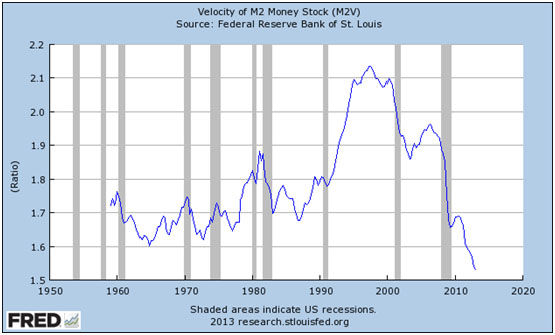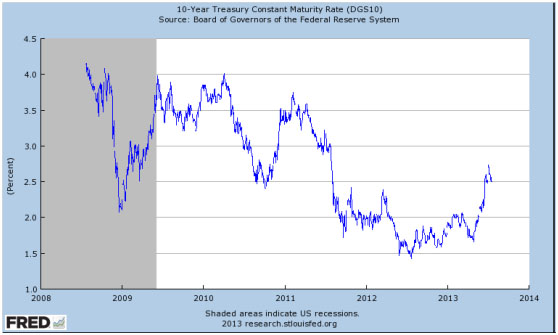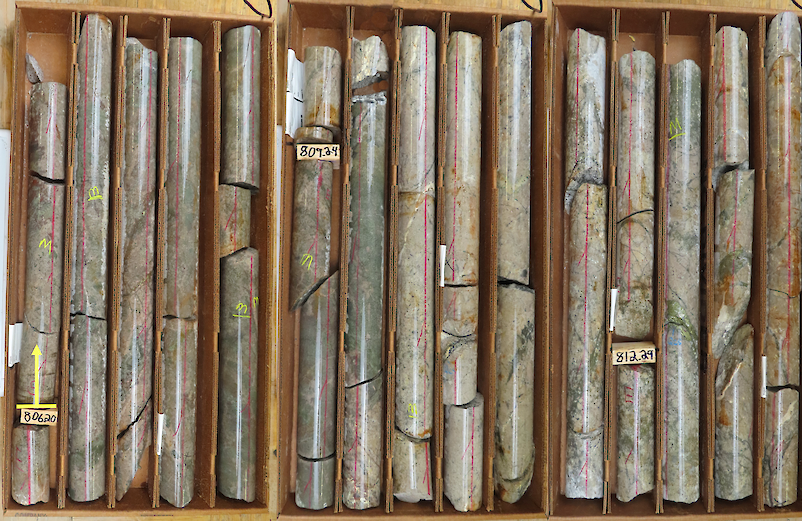The Gold Report: After months of financial media coverage, investors are suffering from quantitative easing (QE) overload. At this point, what's important for investors to know about QE?
Chris Berry: QE appears to be one of the last arrows in the quiver of central bankers in the U.S., the Eurozone and Japan to try and resuscitate the global economy. Successive rounds of QE have failed to ignite demand, which was the stated purpose. Currently, a great deal of economic data supports a deflationary rather than inflationary view.
The Federal Reserve would love to create inflation, as this is the intended effect of easy money from the QE programs. So far, however, the most prevalent inflation we have is asset price inflation rather than in wage growth. This is not what the Fed wants. We're not seeing the "demand pull" inflation typically found when demand is outpacing supply. The two biggest overhangs in the U.S. economy right now are structurally high unemployment and a cratering velocity of money.

This has implications for productivity and demand worldwide. Personal balance sheet deleveraging must continue and will not happen overnight. Fed Chairman Ben Bernanke has clarified his intention to taper QE with the eventual goal of ending it outright. So it's less a question of "if" QE will end, but "when." The Fed wants the U.S. economy to stand on its own two feet and Bernanke's public jawboning is, I think, testing the market's readiness for the official end to monetary easing.
The spike in government bond yields and the increased volatility in the equity markets are signals that market participants are concerned about the end of QE. I still think the huge slack we see in the U.S. economy in aggregate demand has not diminished enough to end QE or similar programs like Operation Twist. Bernanke is walking a tightrope, as QE must end at some point but not too soon as to choke off a tenuous recovery in the U.S. economy.

TGR: Do you believe in "QE to infinity"? Or do you take him at his word that QE will be withdrawn at some point?
CB: QE will end in its current form because it has to. QE distorts the markets in many ways. One example is artificially low interest rates that give a false sense of security to market participants. The Fed's stated target is unemployment below 6.5% or inflation above 2.5%. We're not near either and Bernanke has acknowledged as much in recent statements to the U.S. Congress. Depending upon which Fed governor is speaking, there are different interpretations of where to go from here. This idea of a divided Fed vis-à-vis monetary policy is only adding to uncertainty in the markets.
TGR: What do you expect from the commodity markets as QE is removed?
CB: The only certainty is increased volatility until market participants can clarify the supply and demand dynamics in the absence of QE distortions. As an example, if aggregate demand remains subdued in the absence of QE, this will be negative for industrial metals like lithium, copper or graphite. Similarly, energy prices would also likely remain subdued. Conversely, if QE successfully increases demand and ignites inflation, we could see energy price spikes, which could hamper a global economic recovery.
I realize that I'm waffling a little bit here. Commodity pricing is dependent upon numerous factors, but the ultimate success or failure of QE is crucial to the health of the commodity markets, for sure.
TGR: QE has created several feedback loops that investors could react to in the short term, but that longer term investors might want to ignore. Is that why you're writing about heading to the sidelines as a commodity investor for a few months?
CB: Yes. I recently wrote to subscribers that I was taking a pause in actively investing, and I'm going to re-evaluate this call in late Q3/13, so this is not an indefinite move. It's also undeniable that there are some extraordinarily cheap companies in the junior mining space right now, but it doesn't mean that they can't get cheaper. Coupled with the fact that I view the global economy as essentially treading water right now, I'm just not compelled to aggressively buy shares in the market. Later this year, we're going to know more from the Fed about its intentions on tapering QE and the trajectory of China's slowdown in growth. These are two major catalysts in the marketplace.
Looking to year-end, investors should remember tax-loss selling may pressure the sector. Things may be cheap now, but they could get cheaper. If you're a longer term investor, there is no harm in being on the sidelines. Rather than actively accumulating shares, my current focus is due diligence on a number of companies and metals. That includes reviewing economic data, technological advancements, and listening to clues from CEOs on earnings calls.
TGR: Besides low geopolitical risk, what does your ideal mining investment look like?
CB: Given the challenging environment for the junior mining industry today, it is critical that a company focus on its financial sustainability. A strong balance sheet and the ability to prudently manage cash in the face of declining or stagnant metals prices are absolutely crucial. Management must be able to execute its plans effectively and push forward with an effective exploration or development program—despite the current market sentiment. Management teams can't control the price of gold or copper, for example, and therefore need to focus on cost control and finding opportunities in parts of the world with a record of being mining friendly. Nevada, which produces 80% of U.S. gold, is an excellent example.
TGR: What are the most important factors in selecting a junior mining investment?
CB: First and foremost is the management; its depth of experience is crucial. Second, as I mentioned, is the financial sustainability of the company. Third is the geopolitics. I like Nevada because of the well understood permitting process and respect for the rule of law. I have three favorites in Nevada that I like for different reasons—Terraco Gold Corp. (TEN:TSX.V), Midway Gold Corp. (MDW:TSX.V; MDW:NYSE.MKT) and Pershing Gold Corp. (PGLC:OTCBB).
TGR: Let's start with Terraco. What is the opportunity?
CB: Terraco has sound leadership in CEO Todd Hilditch, as well as very experienced geologic knowledge in Charlie Sulfrian and Dr. Ken Snyder. Terraco is focused on two projects, one in Nevada called Moonlight, which is 8 kilometers north of Coeur Mining Inc.'s (CDM:TSX; CDE:NYSE) Rochester mine, and one in Idaho called Almaden, which contains a Measured resource of 239,000 ounces (239 Koz) gold, an Indicated resource of 625 Koz gold and an Inferred resource of 84 Koz gold.
However, to me the most interesting asset is a royalty Terraco has. This is a net smelter return (NSR) royalty of which Terraco has an option on and owns a portion of up to 3% on the Spring Valley deposit, which Midway Gold and Barrick Gold Corp. (ABX:TSX; ABX:NYSE) are jointly developing. Valuing a royalty is a subjective exercise. My analysis indicates that the value of the Spring Valley royalty could be larger than Terraco's current market cap. To be clear, this is based only on my own assumptions, but it's one of the main reasons I think Terraco is undervalued. It is early days for the company, and I see a lot of unrealized value here.
TGR: Why is Pershing a favorite?
CB: Pershing is to the south of both Terraco and Midway on the Humboldt range. Pershing is substantially derisked relative to a number of other gold exploration and development plays. The company is consolidating a land package with a past-producing mine called Relief Canyon. It's run by Steve Alfers, who has a background as chief of U.S. operations at Franco-Nevada Corp. (FNV:TSX; FNV:NYSE). He has a wealth of experience across the entire mining value chain. Relief Canyon was a past-producing, open-pit mine with low operating costs. The processing facilities at Relief Canyon are fully permitted and refurbished, which lowers the capital expenditures (capex) to get to production.
Relief Canyon has an NI 43-101 in-pit resource of approximately 463 Koz gold in the Measured and Indicated (M&I) categories and approximately 101 Koz in the Inferred category, with additional growth potential. For those investors who take solace in a "major" investing in a junior, one should not overlook the strategic partnership Pershing has initiated with Coeur Mining, which owns over 10 million (10M) shares in the company.
TGR: Do you have any concerns with Pershing's limited cash position?
CB: That is obviously a real challenge for any junior. But given that we know a great deal about the economics of production, and the company has just started a new drill program to increase the size of its resource, this is currently not a concern.
TGR: The other one you mentioned is Midway. Speaking of cash, Midway did a financing at the end of last year and raised at least $70M, so doesn't that put it in a strong position?
CB: Midway is a great story. This is a company with a pipeline of properties, most of which are in Nevada. It has a fantastic cash position and near-term production in the Pan deposit. Pan has a projected capex of about $99M. The deposit is at surface and suited to open-pit mining methods. The Proven and Probable reserves are approximately 864 Koz gold. It will be a low cost producer. Midway is targeting putting Pan into production in 2014. Additionally, Midway has a joint venture with Barrick at Spring Valley, which I alluded to when discussing Terraco.
Barrick has earned into a 60% interest in the joint venture and has stated that it will spend another $8M to earn up to 70%. The deposit has 2.2 Moz gold M&I and approximately 1.97 Moz gold Inferred. Recent additional drilling has potential to increase the size of this resource in the future. Midway has strong, experienced management in all aspects of mining from exploration through development into production. It also has strong institutional support, attractive project economics and the geopolitical stability of Nevada.
TGR: What is the exit strategy for the juniors that we just discussed? Do they require majors with lots of cash?
CB: The exit strategy hasn't changed. The typical junior mining company will explore, make a discovery, develop it to a point and then typically try and position it to a major who is looking to add ounces or pounds to its own pipeline at an attractive, economic price point.
What has changed is how the juniors raise the adequate funds to execute this model. Raising small amounts (say $200,000 at a time) through the traditional equity channels is a recipe for failure and a sure way to slowly dilute shareholders into oblivion. Junior mining companies today must become much more creative in how they raise adequate capital. This may include funding from strategic investors such as life insurance companies looking to increase their overall rate of return or investing in royalties.
Failed mergers and acquisitions are a large part of the reason for many mining companies' CEOs walking the plank recently. Capex on projects got out of hand, and the majors are writing off these projects. Going forward I expect the majors to continue retrenching and writing off assets. That does not bode well for the junior mining sector, but I do believe this is a short-term phenomenon. Ultimately, the major mining companies will need to replace mined ore. That's why the junior mining sector is a critical part of the whole value chain.
TGR: Thanks for taking the time to talk with us. We look forward to checking in with you in the near future.
CB: It has been a pleasure.
Read Chris Berry's ideas on investing in rare earth elements and graphite.
Chris Berry, with a lifelong interest in geopolitics and the financial issues that emerge from these relationships, founded House Mountain Partners in 2010. The firm focuses on the evolving geopolitical relationship between emerging and developed economies, the commodity space and junior mining and resource stocks positioned to benefit from this phenomenon. Berry holds a Master of Business Administration in finance with an international focus from Fordham University, and a Bachelor of Arts in international studies from the Virginia Military Institute.
Want to read more Gold Report interviews like this? Sign up for our free e-newsletter, and you'll learn when new articles have been published. To see a list of recent interviews with industry analysts and commentators, visit our Streetwise Interviews page.
DISCLOSURE:
1) J. Alec Gimurtu conducted this interview for The Gold Report and provides services to The Gold Report as an independent contractor. He or his family own shares of the following companies mentioned in this interview: None.
2) The following companies mentioned in the interview are sponsors of The Gold Report: Terraco Gold Corp., Pershing Gold Corp. and Franco-Nevada Corp. Streetwise Reports does not accept stock in exchange for its services or as sponsorship payment.
3) Chris Berry: I or my family own shares of the following companies mentioned in this interview: Terraco Gold Corp. I personally am or my family is paid by the following companies mentioned in this interview: Pershing Gold Corp. My company has a financial relationship with the following companies mentioned in this interview: None. I was not paid by Streetwise Reports for participating in this interview. Comments and opinions expressed are my own comments and opinions. I had the opportunity to review the interview for accuracy as of the date of the interview and am responsible for the content of the interview.
4) Interviews are edited for clarity. Streetwise Reports does not make editorial comments or change experts' statements without their consent.
5) The interview does not constitute investment advice. Each reader is encouraged to consult with his or her individual financial professional and any action a reader takes as a result of information presented here is his or her own responsibility. By opening this page, each reader accepts and agrees to Streetwise Reports' terms of use and full legal disclaimer.
6) From time to time, Streetwise Reports LLC and its directors, officers, employees or members of their families, as well as persons interviewed for articles and interviews on the site, may have a long or short position in securities mentioned and may make purchases and/or sales of those securities in the open market or otherwise.




































